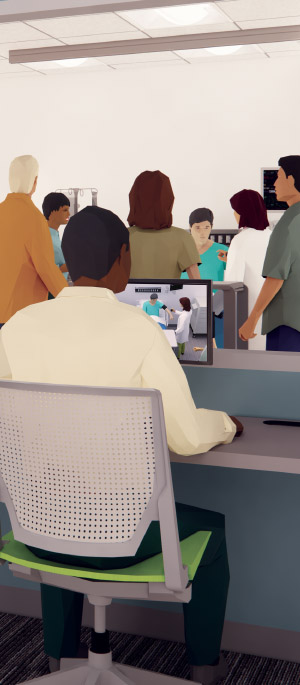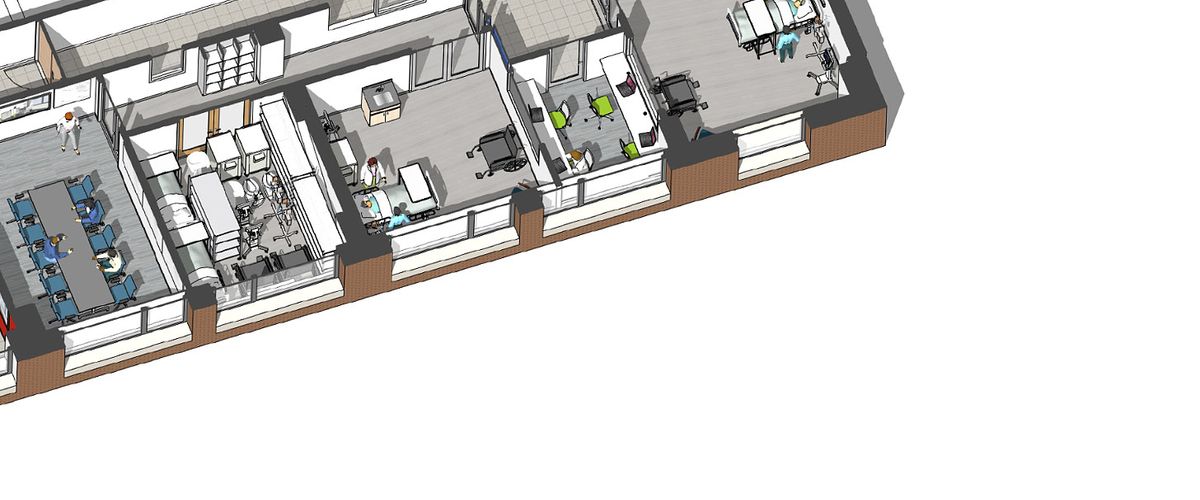DRAWING COURTESY OF SARGENT COLLEGE
Imagine stepping into a radiology suite for the first time. An anxious patient sits on the table, awaiting an uncomfortable barium swallow test. Their nervous partner waits outside the room. Machines beep and whir. Even the weight of the dense lead aprons feels unfamiliar. In that moment, you need to draw on all of your expertise and empathy—and not get distracted by a new environment.
There’s a wide gulf between classroom learning and performing a high-stakes task. It’s why pilots have long trained in flight simulators that can take the form of video games or realistic cockpits anchored to the ground, before trying to land a jet on a runway. Likewise, only practice can prepare a clinician for the experience of interacting with a flesh-and-blood patient. Increasingly, that practice is coming through a variety of healthcare simulations rather than on the job. Early next year, Sargent will close that classroom-to-clinic gulf when it opens the new Center for Clinical Simulation.
The center will occupy a row of rooms on Sargent’s third floor. Two rooms will act as the sets for simulations. Faculty and staff can stage them with props to mimic acute care hospital rooms or radiology suites. There, students can practice in a safe space, opposite trained actors or animatronic mannequins. Faculty, watching the sessions from an observation room, will be able to communicate with participants throughout the experience.
“It’s one thing to provide students with a lot of training in working with a client who had a stroke, so they know what to expect and know how to do an evaluation,” says Michelle Mentis, a clinical professor and chair of speech, language, and hearing sciences (SLHS), who chaired a faculty committee that guided the center’s design. “It’s a very different thing when they actually go into a hospital room. That’s where the [simulation] lab comes in.”

Simulated Education, Real Growth
The use of simulations in healthcare isn’t new. Anatomical models have long been used in classrooms, for example. But in recent years, its use has been on the rise. New technology, from increasingly lifelike mannequins to virtual reality, have made the practice more immersive and realistic. Accreditation boards have begun recognizing the use of simulations in place of some fieldwork. And the pandemic accelerated the expansion of simulation-based education as many hospital and clinic-based placements were suspended. Plus, as simulations become more common, there’s more literature detailing their efficacy, Mentis says. That, in turn, fuels more growth. “It hadn’t been very much a part of our field even five years ago,” she says.
Simulations aren’t entirely new to Sargent, but the center will represent a huge step forward in capacity and sophistication. “Our simulation activities have taken place in a traditional classroom or even my office,” says Marijane Staniec (’96), a senior lecturer and director of the dietetic internship program. “Having fully functional acute care hospital rooms will provide a much more authentic environment for students to practice skills and grow in confidence.”
Mentis says that the SLHS department previously used computer simulation software to teach students how to work through a diagnosis and how to plan treatments. The physical therapy department was already using actors—typically referred to as standardized patients—so students could practice engaging with patients and obtaining histories before they move on to a clinical setting. In occupational therapy, faculty and students often helped each other practice common maneuvers, like bed-to-wheelchair transfers. And nutrition students have practiced several skills with standardized patients, including nutrition counseling and nutrition-focused physical exams.
Anne Escher (’08), a clinical assistant professor, has seen the use of simulations in OT grow in recent years as studies have shown that they increase students’ confidence and comfort levels. And since the last revision of accreditation standards in 2018, students have been able to earn fieldwork credit for participating in simulations. That meant Sargent could offer online simulations with standardized patients in place of clinical placements during the pandemic. “It was really successful, having students think and interact, in the moment, with someone they didn’t know,” Escher says.
Practicing as a Team
Mentis and her SLHS colleagues began planning to expand their own simulation capabilities during the pandemic. That’s when Sargent Dean Christopher Moore, following a series of discussions with each department, recognized that the college needed a state-of-the-art shared space where students could not only practice skills but work together in interdisciplinary teams. The results: the simulations coordinated in the new center will be more holistic and immersive than anything Sargent students have experienced before.
“These simulations will help prepare students to be confident in their clinical skills and contributions to team-based care,” says Craig Slater, a clinical assistant professor of occupational therapy. “Students will be able to apply knowledge and skills in a safe learning environment, where they can receive real-time feedback.” Slater, Sargent’s director for interprofessional education and practice, will help to design those exercises. Sargent is also in the process of hiring a director for the center.
“It’s ideal for teaching students how to work together, which is what they do in the real world,” says Mentis.
These simulations will help prepare students to be confident in their clinical skills and contributions to team-based care. Students will be able to apply knowledge and skills in a safe learning environment, where they can receive real-time feedback.
—Craig Slater
Simulations are much more than practicing hands-on care. Standardized patients can be instructed to challenge students by, for example, questioning their level of experience. Actors may also stand in as family members and partners who are receiving an update on their loved one, and may even require consoling. And faculty will be there to coach students through each of those interactions.
“That’s part of an education in health and rehabilitation sciences that’s sometimes talked about but not taught,” Escher says. “But that is the piece that determines whether an intervention is successful.”
